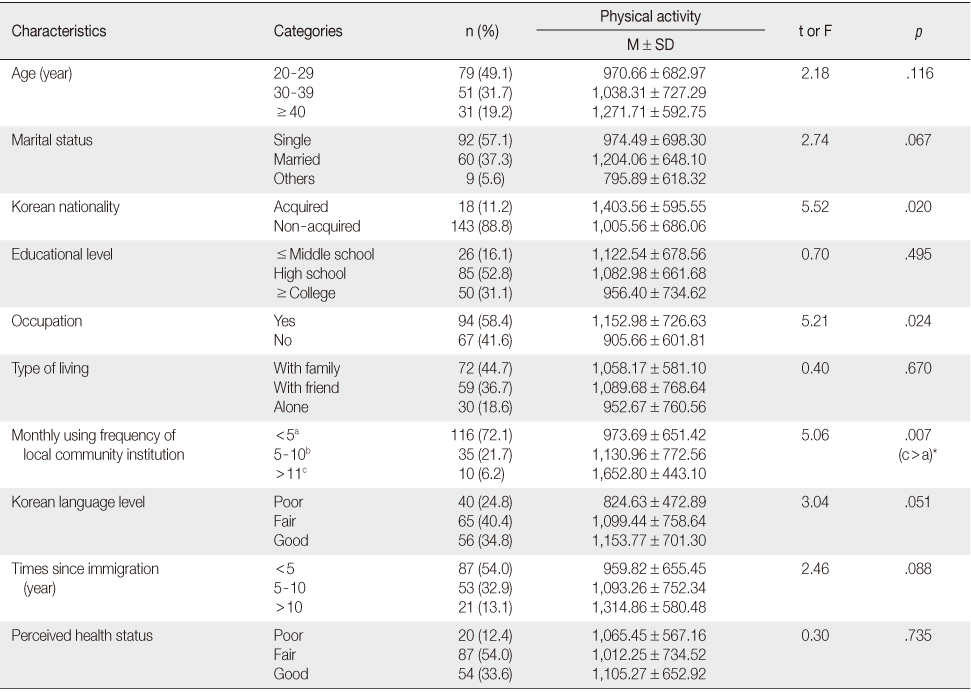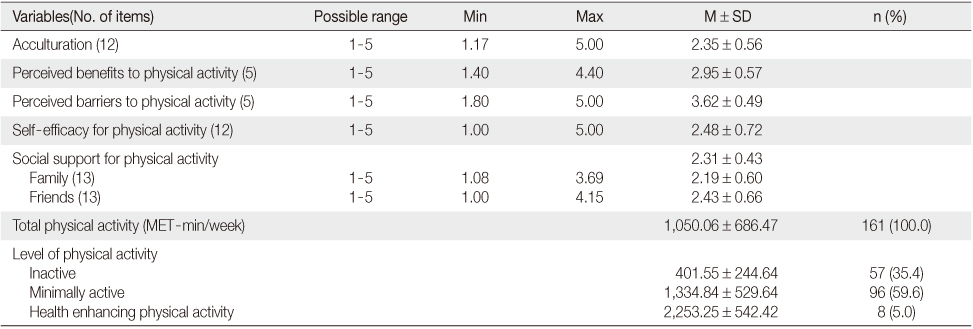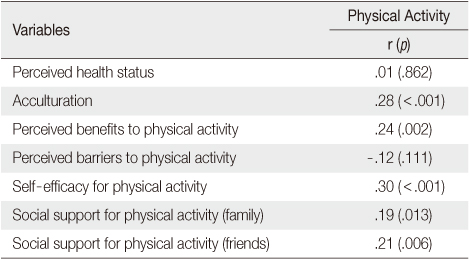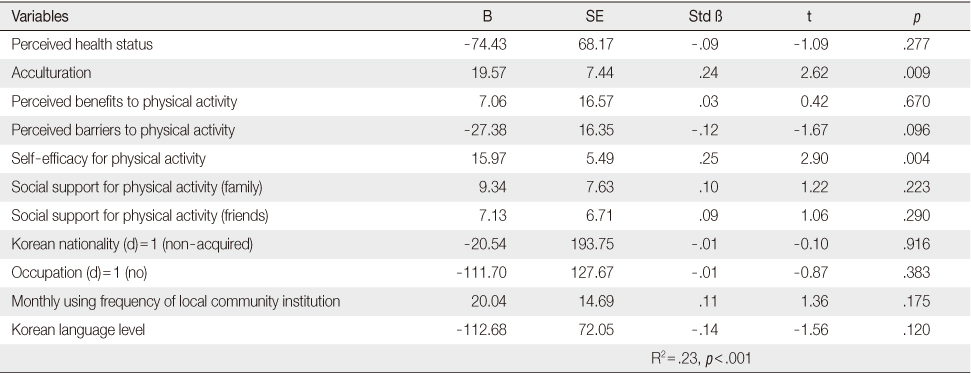Articles
- Page Path
- HOME > J Korean Acad Nurs > Volume 43(6); 2013 > Article
-
Original Article
- Factors Associated with Physical Activity among Chinese Immigrant Women
- Sung-Hye Cho, Hyeonkyeong Lee
-
Journal of Korean Academy of Nursing 2013;43(6):760-769.
DOI: https://doi.org/10.4040/jkan.2013.43.6.760
Published online: December 31, 2013
1College of Nursing, Yonsei University, Seoul, Korea.
2College of Nursing, Nursing Policy Research Institute, Yonsei University, Seoul, Korea.
- Address reprint requests to: Lee, Hyeonkyeong. College of Nursing, Yonsei University, 50 Yonsei-ro, Seodaemun-gu, Seoul 120-749, Korea. Tel: +82-2-2228-3373, Fax: +82-2-392-5440, hlee39@yuhs.ac
© 2013 Korean Society of Nursing Science
Abstract
-
Purpose
- This study was done to assess the level of physical activity among Chinese immigrant women and to determine the relationships of physical activity with individual characteristics and behavior-specific cognition.
-
Methods
- A cross-sectional descriptive study was conducted with 161 Chinese immigrant women living in Busan. A health promotion model of physical activity adapted from Pender's Health Promotion Model was used. Self-administered questionnaires were used to collect data during the period from September 25 to November 20, 2012. Using SPSS 18.0 program, descriptive statistics, t-test, analysis of variance, correlation analysis, and multiple regression analysis were done.
-
Results
- The average level of physical activity of the Chinese immigrant women was 1,050.06±686.47 MET-min/week and the minimum activity among types of physical activity was most dominant (59.6%). As a result of multiple regression analysis, it was confirmed that self-efficacy and acculturation were statistically significant variables in the model (p<.001), with an explanatory power of 23.7%.
-
Conclusion
- The results indicate that the development and application of intervention strategies to increase acculturation and self-efficacy for immigrant women will aid in increasing the physical activity in Chinese immigrant women.
- 1. Andersen E, Burton NW, Anderssen SA. Physical activity levels six months after a randomised controlled physical activity intervention for Pakistani immigrant men living in Norway. Int J Behav Nutr Phys Act. 2012;9:47. http://dx.doi.org/10.1186/1479-5868-9-47ArticlePubMedPMC
- 2. Craig CL, Marshall AL, Sjostrom M, Bauman AE, Booth ML, Ainsworth BE, et al. International physical activity questionnaire: 12-country reliability and validity. Med Sci Sports Exerc. 2003;35(8):1381–1395. http://dx.doi.org/10.1249/01.mss.0000078924.61453.fbArticlePubMed
- 3. Eyler AA, Matson-Koffman D, Young DR, Wilcox S, Wilbur J, Thompson JL, et al. Quantitative study of correlates of physical activity in women from diverse racial/ethnic groups: The women's cardiovascular health network project summary and conclusions. Am J Prev Med. 2003;25:3 Suppl 1. 93–103.ArticlePubMed
- 4. Faul F, Erdfelder E, Buchner A, Lang AG. Statistical power analyses using G*Power 3.1: Tests for correlation and regression analyses. Behav Res Methods. 2009;41(4):1149–1160. http://dx.doi.org/10.3758/brm.41.4.1149ArticlePubMedPDF
- 5. Gerber M, Barker D, Pühse U. Acculturation and physical activity among immigrants: A systematic review. Z Gesundh Wiss. 2012;20(3):313–341. http://dx.doi.org/10.1007/s10389-011-0443-1ArticlePDF
- 6. Gidengil E, Stolle D. The role of social networks in immigrant women’s political incorporation. Int Migr Rev. 2009;43(4):727–763. http://dx.doi.org/10.1111/j.1747-7379.2009.00783.xArticlePDF
- 7. Gordon-Larsen P, Harris KM, Ward DS, Popkin BM. Acculturation and overweight-related behaviors among Hispanic immigrants to the US: The National Longitudinal Study of Adolescent Health. Soc Sci Med. 2003;57(11):2023–2034.ArticlePubMed
- 8. International Physical Activity Questionnaire. Guidelines for data processing and analysis of the international physical activity questionnaire (IPAQ): Short and long forms. 2005;Retrieved January 16, 2006. from www.ipaq.ki.se/scoring.pdf?.
- 9. Jeong N, Lee MH. A predictive model on health promotion behavior in women who immigrate for marriage. J Korean Acad Nurs. 2010;40(5):695–704. http://dx.doi.org/10.4040/jkan.2010.40.5.695ArticlePubMed
- 10. Kim H, Yoo S, Cho S, Kwon EJ, Kim S, Park JY. Health status and associated health risks among female marriage immigrants in Korea. Korean J Health Educ Promot. 2010;27(5):79–89.Article
- 11. Kim SK, Kim YK, Cho AJ, Kim HR, Lee HK, Seol DH, et al. A national survey on multicultural families 2009 (2010-06). Seoul: Ministry of Health & Welfare, Ministry of Justice Republic of Korea, Ministry of Gender Equality & Family Republic of Korea, The Korea Institute for Health and Social Affairs; 2010.
- 12. Korea Institute for Health And Social Affairs. The national health plan 2020 of Korea. 2010;Retrieved March 31, 2011. from http://www.kihasa.re.kr/html/jsp
- 13. Lara M, Gamboa C, Kahramanian MI, Morales LS, Bautista DE. Acculturation and Latino health in the United States: A review of the literature and its sociopolitical context. Annu Rev Public Health. 2005;26:367–397. http://dx.doi.org/10.1146/annurev.publhealth.26.021304.144615ArticlePubMedPMC
- 14. Lee MR. Predicting exercise behavior in middle-aged women: Extended theory of planned behavior. J Korean Acad Adult Nurs. 2001;13(4):610–619.
- 15. Ma WF. Predictors of regular physical activity among adults with anxiety in Taiwan. Austin, TX, The University of Texas at Austin. 2005;Unpublished doctoral dissertation.
- 16. Marin G, Sabogal F, Marin BV, Otero-Sabogal R, Perez-Stable EJ. Development of a short acculturation scale for hispanics. Hisp J Behav Sci. 1987;9(2):183–205. http://dx.doi.org/10.1177/07399863870092005ArticlePDF
- 17. Ministry of Health and Welfare, & Korea Center for Disease Control and Prevention. Korea health statistics 2010: Korean national health and nutrition examination survey (KNHANES V-1). 2012;Retrieved Jan 5, 2012. from http://knhanes.cdc.go.kr
- 18. Netto G, Bhopal R, Lederle N, Khatoon J, Jackson A. How can health promotion interventions be adapted for minority ethnic communities? Five principles for guiding the development of behavioural interventions. Health Promot Int. 2010;25(2):248–257. http://dx.doi.org/10.1093/heapro/daq012ArticlePubMed
- 19. Pender NJ. Health promotion in nursing practice. 3rd ed. Stamford, CT: Appleton and Lange; 1996.
- 20. Plotnikoff RC, Blanchard C, Hotz SB, Rhodes R. Validation of the decisional balance scales in the exercise domain from the transtheoretical model: A longitudinal test. Meas Phys Educ Exerc Sci. 2001;5(4):191–206. http://dx.doi.org/10.1207/S15327841MPEE0504_01Article
- 21. Sallis JF, Grossman RM, Pinski RB, Patterson TL, Nader PR. The development of scales to measure social support for diet and exercise behaviors. Prev Med. 1987;16(6):825–836.ArticlePubMed
- 22. Sallis JF, Pinski RB, Grossman RM, Patterson TL, Nader PR. The development of self-efficacy scales for healthrelated diet and exercise behaviors. Health Educ Res. 1988;3(3):283–292. http://dx.doi.org/10.1093/her/3.3.283Article
- 23. Si Q, Yu K, Cardinal BJ, Lee H, Yan Z, Loprinzi PD, et al. Promoting exercise behavior among Chinese youth with hearing loss: A randomized controlled trial based on the transmtheoretical model. Psychol Rep. 2011;109(3):896–906.ArticlePubMedPDF
- 24. Ståhl T, Rütten A, Nutbeam D, Bauman A, Kannas L, Abel T, et al. The importance of the social environment for physically active lifestyle-results from an international study. Soc Sci Med. 2001;52(1):1–10.ArticlePubMed
- 25. Statistics Korea. Internal Migration Statistics: Number of internal migrants for city, county, and district. 2012;Retrieved January, 2012. http://kosis.kr/eng/database/database_001000.jsp?listid=A&subtitle=Population/Household
- 26. Tung WC, Hsu CH. Assessing transcultural validity of the transtheoretical model with Chinese Americans and physical activity. J Transcult Nurs. 2009;20(3):286–295. http://dx.doi.org/10.1177/1043659609334929ArticlePubMedPDF
- 27. U.S. Department of Health & Human Services. Physical activity fundamental to preventing disease. 2002;Retrieved June 20, 2002. http://aspe.hhs.gov/health/reports/physicalactivity/physicalactivity.pdf
- 28. Yang K, Laffrey SC, Stuifbergen A, Im EO, May K, Kouzekanani K. Leisure-time physical activity among midlife Korean immigrant women in the US. J Immigr Minor Health. 2007;9(4):291–298. http://dx.doi.org/10.1007/s10903-007-9039-9ArticlePubMedPDF
- 29. Yang SJ. Health behaviors and related factors among Asian immigrant women in Korea by ethnicity. J Korean Acad Community Health Nurs. 2011;22(1):66–74.Article
- 30. Zhao Y, Sigmund E, Sigmundová D, Lu Y. Comparison of physical activity between Olomouc and Beijing university students using an international physical activity questionnaire. Acta Univ Palacki Olomuc Gymn. 2007;37(4):107–114.
REFERENCES
Figure & Data
REFERENCES
Citations

- Exercise health belief model mediates the relationship between physical activity and peer support among Chinese college students: A cross-sectional survey
Jiazhi Sheng, Lamei Gong, Jian Zhou
Frontiers in Psychology.2023;[Epub] CrossRef - The Current Health Belief of Exercise Conditions of Chinese College Students and Ways of Improvements: An Analysis Based on the Health Belief Model
Lamei Gong, Jiazhi Sheng
Frontiers in Psychology.2022;[Epub] CrossRef - Factors Influencing the Physical Activity of Foreign Workers: Based on a Health Promotion Model
Jeong Eui Cho, Yeongmi Ha
Journal of Korean Academy of Community Health Nursing.2021; 32(3): 344. CrossRef - Development and evaluation of the health belief model scale for exercise
Shiyan Wu, Xinglin Feng, Xinying Sun
International Journal of Nursing Sciences.2020; 7: S23. CrossRef - Effects of culturally adaptive walking intervention on cardiovascular disease risks for middle-aged Korean-Chinese female migrant workers
Hyeonkyeong Lee, Sunghye Cho, JoEllen Wilbur, Junghee Kim, Chang-gi Park, Young-Me Lee, Haryong Lee
Archives of Environmental & Occupational Health.2017; 72(6): 317. CrossRef - Relationship between Expectations Regarding Aging and Physical Activity among Middle Aged Adults in Urban Areas: Based on the Pender's Health Promotion Model
Sung-Hye Cho, MoonKi Choi, JuHee Lee, Hyewon Cho
Journal of Korean Academy of Nursing.2015; 45(1): 14. CrossRef - Acculturation, Social Network, and Health-related Quality of Life in Korean-Chinese Immigrants
Meenhye Lee, Hyeonkyeong Lee, Sue Kim, Yeonsoo Jang
Journal of Korean Academy of Community Health Nursing.2013; 24(4): 438. CrossRef
Physical Activity by Individual Characteristics (N=161)
*Scheffé test.
Physical Activity and Acculturation, Perceived Benefits/Barriers, Self-efficacy, Social Support (N=161)
MET-min/week=MET level×minutes of activity×events per week; MET level: Vigorous intensity (8), Moderate intensity (4), Walking (3.3).
Correlations of related Variables with Physical Activity (N=161)
Regression Analysis for Variables Predicting Physical Activity (N=161)
*Scheffé test.
MET-min/week=MET level×minutes of activity×events per week; MET level: Vigorous intensity (8), Moderate intensity (4), Walking (3.3).
 KSNS
KSNS
 E-SUBMISSION
E-SUBMISSION




 Cite
Cite

